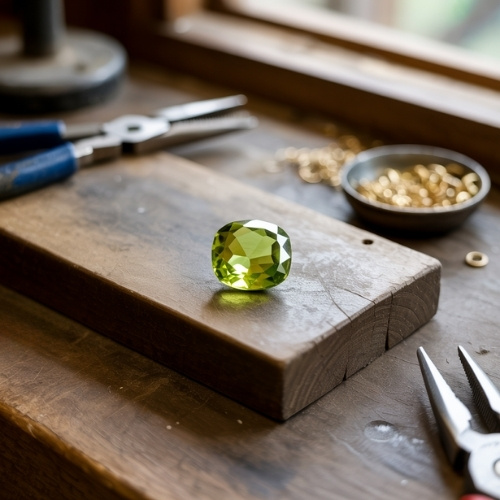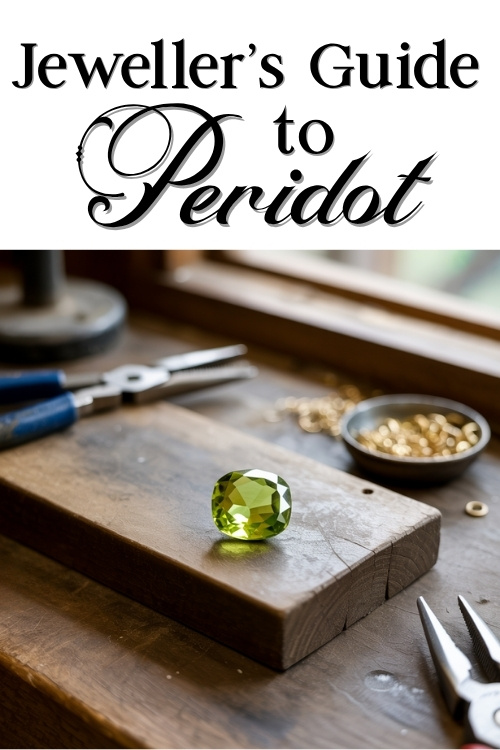Estimated reading time: 5 minutes
From its ancient associations with the sun to its modern popularity in bold, contemporary designs, peridot has something for everyone. Whether you’re creating a minimalist pendant or a dazzling statement ring, peridot is sure to steal the spotlight.
Jump to:
Basic Identification Information
Name & Synonyms:
Peridot; sometimes referred to as chrysolite or evening emerald in older texts.
Species:
Olivine
Colour Range:
Yellowish-green to green, with vivid lime tones considered the most desirable.
Refractive Index:
1.654–1.690
Birefringence:
0.035–0.038
This high birefringence often causes visible doubling under magnification. (look for doubled facet junctions when using a loupe)
Optical Sign:
Biaxial + or −
Pleochroism:
Weak to morderate strength and 2 colours
Green and Yellow-green
Specific Gravity:
3.34
Fluorescence:
None
Lustre:
Vitreous – glass-like
Clarity:
Type II
Usually included, though eye-clean examples are also quiet common.
Peridot’s distinctive “lily pad” inclusions are unique to this gem and can help confirm identity.
Gems Often Mistaken For:
Green tourmaline, green sapphire, demantoid garnet
Mohs Hardness:
6.5–7
Wearability:
Good
Birthstone:
August (along with spinel)
Spotting Synthetic (Lab-Grown) Peridot
Synthetic peridot does exists but is rarely seen in the jewellery market as it tends to be produced for research or industrial uses. When it does appear, it can be challenging to distinguish by eye. Lab-grown examples tend to be too perfect, with no inclusions, even under magnification, and flawless colour saturation.
In contract, when examined under a microscope, natural peridot often shows lily pad inclusions, irregular growth patterns, or tiny platelets.
Common Treatments
Peridot is almost always untreated, which makes it something of a rarity among coloured gemstones. Its rich colour is entirely natural, and treated stones are virtually unheard of in the commercial jewellery space.
Durability & Setting Considerations
Peridot has a Mohs hardness of 6.5 to 7, making it reasonably durable but not as tough as some of the more commonly used gems in jewellery. Its structure is slightly brittle, which means it can chip or fracture if subjected to a hard knock or sudden pressure. This brittleness, combined with its sensitivity to both heat and acids, makes careful handling essential, particularly during setting or repair.
When working with peridot, jewellers should opt for protective settings wherever possible. Bezel settings or deep prong styles can help shield the stone’s edges from impact and wear. Tension settings and open designs, while visually striking, are best avoided unless the piece is intended for occasional wear.
Because peridot doesn’t tolerate high temperatures well, it should always be unmounted before any soldering or other heat work. Leaving it in place risks causing permanent damage through thermal shock.
Finally, take care when applying pressure during setting. Like many brittle gems, peridot has natural cleavage planes that can break under stress. Gentle, controlled handling is the key to showcasing this vibrant green gem safely and beautifully.
🛍️ Explore our selection of pre-owned Peridot Gemstones for your next jewellery creation.
Care Instructions
Cleaning:
Use warm, soapy water and a soft brush. Avoid ultrasonic or steam cleaners, as the vibrations and heat can cause internal fractures or surface damage.
Storage:
Store peridot jewellery separately from harder gems such as quartz, topaz, or diamond to prevent scratching.
Daily Wear:
Remove rings or bracelets before physical activity such as gardening, gym sessions, or housework, to reduce the chance of accidental knocks or abrasion.
Market & Ethical Notes
Peridot is mainly sourced from volcanic deposits. Key locations include the San Carlos Reservation in Arizona (USA), China, Myanmar, and Pakistan. The finest peridot often comes from Pakistan’s Kashmir region, prized for its saturated lime-green hues and exceptional clarity.
While peridot is generally affordable, large or high-grade stones can fetch high prices.
As with all gemstones, ethical sourcing can vary by region, so working with transparent, reputable suppliers is essential.
🔗 Learn more about the ethical and environmental story behind Reclaimed and Recycled Gemstones.
Symbolic & Spiritual Meanings
Peridot is believed to protect against negativity and radiate life-affirming energy. Ancient Egyptians wore it to ward off evil spirits and nightmares, while today it’s associated with prosperity, renewal, and inner warmth.
Peridot is often linked to the heart chakra, supporting emotional healing and a sense of lightness in spirit.
🔗 Dive deeper into Peridot’s Symbolic & Spiritual Meanings
Etymology
The origin of the word peridot is still debated. Many scholars trace it back to the Arabic faridat, meaning “gem” or “precious stone”, a nod to its historical mining on St. John’s Island (Zabargad) in the Red Sea, where Arabic-speaking traders once thrived.
Others point to the Old French term peritot, which means “unclear” or “unspecified.” This may reflect the gem’s misty green hue or its historical confusion with other green stones like emerald.
The English use of “peridot” dates back at least to the 18th century, when it was adopted to clearly distinguish the gem from other green varieties.
🔗Curious about how peridot was viewed in ancient cultures? Explore Peridot Myths and Legends
📌 Save this jeweller’s guide to peridot for quick reference next time you’re working with this stunning gem.


